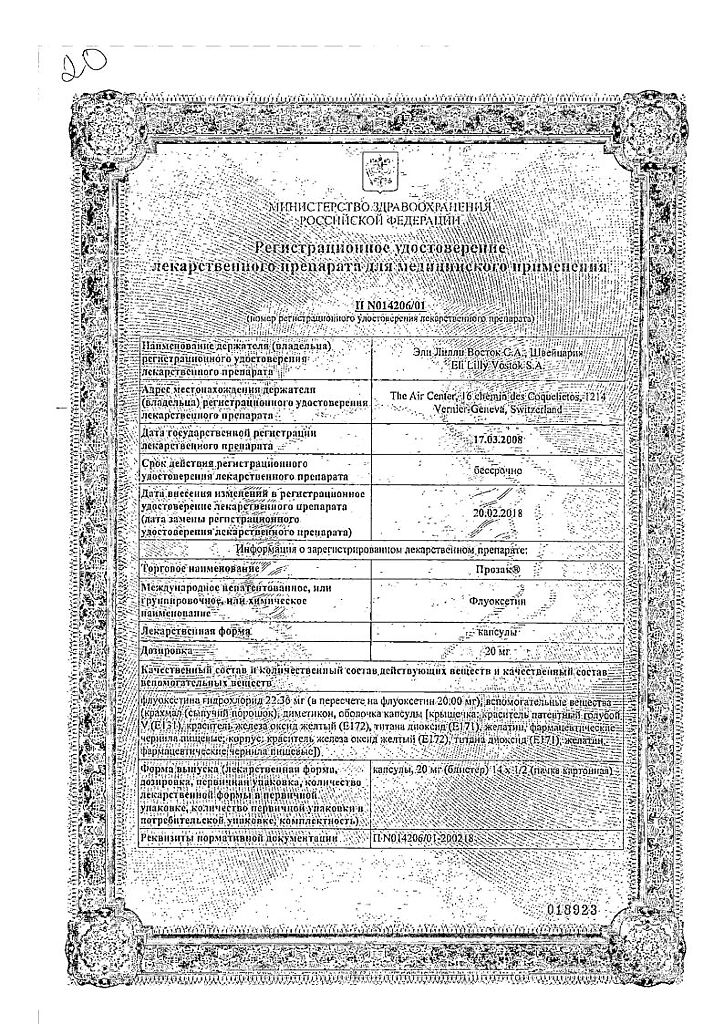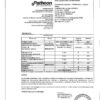No products in the cart.
Prozac, 20 mg capsules 14 pcs
€8.15 €7.13
Out of stock
(E-mail when Stock is available)
Description
An antidepressant. It is a selective serotonin reuptake inhibitor, which determines its mechanism of action. Fluoxetine has practically no affinity for other receptors, such as α1-, α2- and β-adrenoreceptors, serotonin receptors, dopamine receptors, histamine H1-receptors, m-cholinoreceptors and GABA-receptors.
Pharmacokinetics
Intake
After oral administration is well absorbed from the gastrointestinal tract. Cmax is reached after 6-8 hours.
Bioavailability when taken orally is more than 60%. Oral dosage forms of fluoxetine are bioequivalent.
Distribution
The binding to plasma proteins is more than 90%. It is distributed throughout the body. Css in plasma is reached after several weeks of taking the drug. Css after prolonged use of the drug is similar to the concentrations observed at 4-5 weeks of the drug.
Metabolism
Intensively metabolized in the liver to norfluoxetine and a number of other unidentified metabolites.
Elimination
Extracted in the urine as metabolites. The T1/2 of fluoxetine is 4-6 days, and its main active metabolite is 4-16 days.
Indications
Indications
– depression of various etiologies;
– bulimia nervosa;
– obsessive-compulsive disorder;
– premenstrual dysphoric disorder.
Pharmacological effect
Pharmacological effect
Antidepressant. It is a selective serotonin reuptake inhibitor, which determines its mechanism of action. Fluoxetine has virtually no affinity for other receptors, for example, α1-, α2- and β-adrenergic receptors, serotonin receptors, dopamine receptors, histamine H1 receptors, m-cholinergic receptors and GABA receptors.
Pharmacokinetics
Suction
After oral administration, it is well absorbed from the gastrointestinal tract. Cmax is reached after 6-8 hours.
Bioavailability when taken orally is more than 60%. Oral dosage forms of fluoxetine are bioequivalent.
Distribution
Binding to blood plasma proteins is more than 90%. Distributed throughout the body. Css in plasma is achieved after taking the drug for several weeks. Css after long-term use of the drug is similar to the concentrations observed at 4-5 weeks of drug use.
Metabolism
Intensively metabolized in the liver to norfluoxetine and a number of other unidentified metabolites.
Removal
Excreted in urine in the form of metabolites. T1/2 of fluoxetine is 4-6 days, and its main active metabolite is 4-16 days.
Special instructions
Special instructions
There are reports of skin rashes, anaphylactic reactions and progressive systemic disorders involving the skin, lungs, liver, and kidneys in the pathological process in patients taking fluoxetine. If a skin rash or other possible allergic reaction occurs, the etiology of which cannot be determined, Prozac should be discontinued.
As with other antidepressants, Prozac should be used with caution in patients with a history of epileptic seizures.
When using fluoxetine, there have been cases of hyponatremia (in some cases, the level of sodium in the blood was less than 110 mmol/l). Mostly, such cases were observed in elderly patients and in patients receiving diuretics, due to a decrease in blood volume.
In patients with diabetes mellitus, hypoglycemia was observed during treatment with Prozac, and hyperglycemia was observed after discontinuation of the drug. At the beginning and after the end of treatment with fluoxetine, dose adjustments of insulin and/or oral hypoglycemic drugs may be required.
Experimental results
There is no evidence of carcinogenicity from in vitro or animal studies.
Use in pediatrics
The safety and effectiveness of Prozac in children have not been established.
Impact on the ability to drive vehicles and operate machinery
Drugs that affect mental functioning may affect decision-making and driving skills. Patients should be advised to avoid driving a car or operating dangerous machinery until it has been established that the drug does not affect the ability to perform these types of activities.
Active ingredient
Active ingredient
Fluoxetine
Composition
Composition
fluoxetine (hydrochloride form) 20 mg
Excipients:
starch,
Dimethicone
Composition of the capsule shell:
patented blue dye (patent blue dye V), yellow iron oxide dye, titanium dioxide, gelatin, food ink (for applying an identification seal).
Pregnancy
Pregnancy
Experimental studies on animals did not reveal direct or indirect negative effects of fluoxetine on the development of the embryo or fetus or on the course of pregnancy.
There is no evidence of mutagenicity or impairment of fertility from in vitro or animal studies. Because animal reproduction studies do not always predict human response, Prozac should be used during pregnancy only when absolutely necessary.
Fluoxetine is excreted in breast milk, so the drug should be administered with caution to nursing mothers.
The effect of fluoxetine on labor in humans is unknown.
Contraindications
Contraindications
– established hypersensitivity to fluoxetine.
Side Effects
Side Effects
From the digestive system: diarrhea, nausea, vomiting, dysphagia, dyspepsia, taste perversion; in isolated cases – idiosyncratic hepatitis.
From the central nervous system and peripheral nervous system: convulsions, ataxia, bucco-glossal syndrome, myoclonus, tremor, anorexia (up to weight loss), anxiety accompanied by palpitations, restlessness, nervousness, agitation, dizziness, fatigue (drowsiness, asthenia), impaired concentration and thinking, manic reaction, sleep disorders (unusual dreams, insomnia); visual impairment (mydriasis, blurred vision); disorders of the autonomic nervous system (dry mouth, increased sweating, vasodilation, chills), serotonin syndrome (a complex of clinical manifestations of changes in mental state and neuromuscular activity in combination with autonomic disorders of the nervous system).
From the genitourinary system: urinary disorders (including frequent urination), priapism/prolonged erection, sexual disorders (decreased libido, delayed or absent ejaculation, lack of orgasm, impotence).
From the endocrine system: disorders of ADH secretion.
Allergic reactions: itching, skin rash, urticaria, anaphylactic reactions, vasculitis, reactions similar to serum sickness.
Dermatological reactions: photosensitivity, alopecia.
Other: yawning, ecchymosis.
Interaction
Interaction
Prozac should not be co-administered with MAO inhibitors and for at least 14 days after stopping treatment with MAO inhibitors. After discontinuation of fluoxetine and initiation of treatment with MAO inhibitors, there should be an interval of at least 5 weeks. If long-term treatment with fluoxetine was carried out and/or the drug was used in high doses, then this interval should be increased. Among patients who had previously taken fluoxetine and started taking MAO inhibitors at a shorter interval, serious cases of serotonin syndrome (manifestations of which may be similar to NMS), including death, have been reported.
Fluoxetine has the ability to inhibit the CYP2D6 isoenzyme. Therefore, treatment with drugs that are metabolized by this system and that have a narrow therapeutic index should be started with the lowest doses if the patient is concurrently receiving fluoxetine or has taken it within the previous 5 weeks. If fluoxetine is included in the treatment regimen of a patient already taking a similar drug, a reduction in the dose of the first drug should be considered.
When used concomitantly with Prozac, changes in blood concentrations of phenytoin, carbamazepine, haloperidol, clozapine, diazepam, alprazolam, lithium, imipramine and desipramine are observed, and in some cases toxic effects were observed. When taking fluoxetine in combination with these drugs, conservative dosage selection should be provided and the patient’s condition should be monitored.
Fluoxetine is tightly bound to plasma proteins. Therefore, when prescribing fluoxetine while using another drug that binds tightly to plasma proteins, changes in the plasma concentrations of both drugs are possible.
When fluoxetine was used concomitantly with warfarin, an increase in bleeding time was observed. Changes in anticoagulant action (laboratory values and/or clinical signs and symptoms) were inconsistent. As with warfarin in combination with many other drugs, close monitoring of blood clotting parameters should be performed when fluoxetine is initiated or discontinued during warfarin therapy.
If it is necessary to prescribe other drugs after discontinuation of Prozac, the long half-life of fluoxetine and its active metabolite norfluoxetine and, therefore, the possibility of drug interactions should be taken into account.
There have been rare cases of increased duration of seizures in patients taking fluoxetine during electroconvulsive therapy.
Overdose
Overdose
Symptoms: nausea, vomiting, seizures, dysfunction of the cardiovascular system (from asymptomatic arrhythmias to cardiac arrest), dysfunction of the respiratory system and signs of changes in the state of the central nervous system from excitation to coma.
Cases of overdose of fluoxetine alone are usually mild, and death has been extremely rare.
Treatment: monitoring of general condition and cardiac activity along with general symptomatic and supportive therapy. A specific antidote is unknown. The effectiveness of forced diuresis, dialysis, hemoperfusion, and cross-transfusion is unlikely.
When treating an overdose, the possibility of using multiple drugs should be considered.
Storage conditions
Storage conditions
The drug should be stored at room temperature (from 15° to 30°C), out of the reach of children.
Shelf life
Shelf life
3 years.
Manufacturer
Manufacturer
Patheon France, France
Additional information
| Shelf life | 3 years. |
|---|---|
| Conditions of storage | The drug should be stored at room temperature (from 15 ° to 30 ° C), out of reach of children. |
| Manufacturer | Lilly del Caribe Inc., Puerto Rico |
| Medication form | capsules |
| Brand | Lilly del Caribe Inc. |
Related products
Buy Prozac, 20 mg capsules 14 pcs with delivery to USA, UK, Europe and over 120 other countries.


















